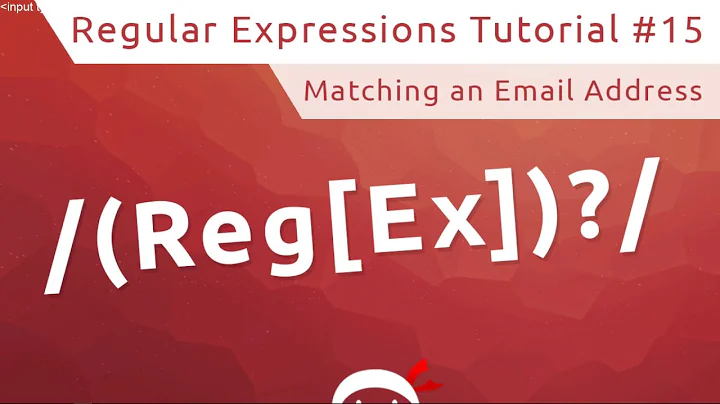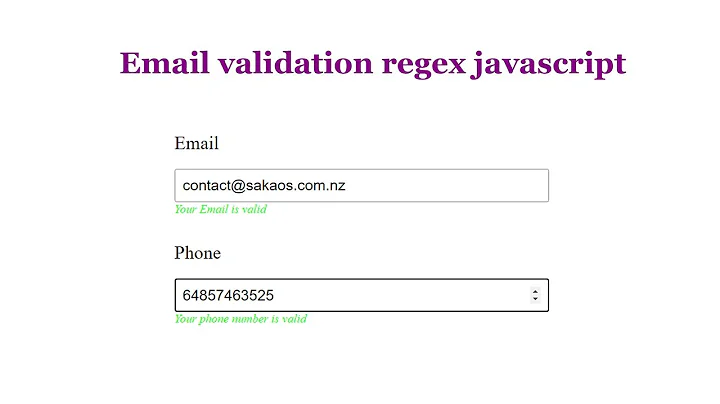Validating email addresses using jQuery and regex
443,899
Solution 1
UPDATES
- http://so.lucafilosofi.com/jquery-validate-e-mail-address-regex/
- using new regex
- added support for Address tags (+ sign)
function isValidEmailAddress(emailAddress) {
var pattern = /^([a-z\d!#$%&'*+\-\/=?^_`{|}~\u00A0-\uD7FF\uF900-\uFDCF\uFDF0-\uFFEF]+(\.[a-z\d!#$%&'*+\-\/=?^_`{|}~\u00A0-\uD7FF\uF900-\uFDCF\uFDF0-\uFFEF]+)*|"((([ \t]*\r\n)?[ \t]+)?([\x01-\x08\x0b\x0c\x0e-\x1f\x7f\x21\x23-\x5b\x5d-\x7e\u00A0-\uD7FF\uF900-\uFDCF\uFDF0-\uFFEF]|\\[\x01-\x09\x0b\x0c\x0d-\x7f\u00A0-\uD7FF\uF900-\uFDCF\uFDF0-\uFFEF]))*(([ \t]*\r\n)?[ \t]+)?")@(([a-z\d\u00A0-\uD7FF\uF900-\uFDCF\uFDF0-\uFFEF]|[a-z\d\u00A0-\uD7FF\uF900-\uFDCF\uFDF0-\uFFEF][a-z\d\-._~\u00A0-\uD7FF\uF900-\uFDCF\uFDF0-\uFFEF]*[a-z\d\u00A0-\uD7FF\uF900-\uFDCF\uFDF0-\uFFEF])\.)+([a-z\u00A0-\uD7FF\uF900-\uFDCF\uFDF0-\uFFEF]|[a-z\u00A0-\uD7FF\uF900-\uFDCF\uFDF0-\uFFEF][a-z\d\-._~\u00A0-\uD7FF\uF900-\uFDCF\uFDF0-\uFFEF]*[a-z\u00A0-\uD7FF\uF900-\uFDCF\uFDF0-\uFFEF])\.?$/i;
return pattern.test(emailAddress);
}
if( !isValidEmailAddress( emailaddress ) ) { /* do stuff here */ }
- NOTE: keep in mind that no 100% regex email check exists!
Solution 2
This is my solution:
function isValidEmailAddress(emailAddress) {
var pattern = new RegExp(/^[+a-zA-Z0-9._-]+@[a-zA-Z0-9.-]+\.[a-zA-Z]{2,4}$/i);
// alert( pattern.test(emailAddress) );
return pattern.test(emailAddress);
};
Found that RegExp over here: http://mdskinner.com/code/email-regex-and-validation-jquery
Solution 3
$(document).ready(function() {
$('#emailid').focusout(function(){
$('#emailid').filter(function(){
var email = $('#emailid').val();
var emailReg = /^([\w-\.]+@([\w-]+\.)+[\w-]{2,4})?$/;
if ( !emailReg.test( email ) ) {
alert('Please enter valid email');
} else {
alert('Thank you for your valid email');
}
});
});
});
Solution 4
Lolz this is much better
function isValidEmailAddress(emailAddress) {
var pattern = new RegExp(/^([\w-\.]+@([\w-]+\.)+[\w-]{2,4})?$/);
return pattern.test(emailAddress);
};
Solution 5
I would recommend that you use the jQuery plugin for Verimail.js.
Why?
- IANA TLD validation
- Syntax validation (according to RFC 822)
- Spelling suggestion for the most common TLDs and email domains
- Deny temporary email account domains such as mailinator.com
How?
Include verimail.jquery.js on your site and use the function:
$("input#email-address").verimail({
messageElement: "p#status-message"
});
If you have a form and want to validate the email on submit, you can use the getVerimailStatus-function:
if($("input#email-address").getVerimailStatus() < 0){
// Invalid email
}else{
// Valid email
}
Related videos on Youtube
Author by
RussP
Updated on November 26, 2020Comments
-
RussP over 3 years
I'm not too sure how to do this. I need to validate email addresses using regex with something like this:
[a-z0-9!#$%&'*+/=?^_`{|}~-]+(?:\.[a-z0-9!#$%&'*+/=?^_`{|}~-]+)*@(?:[a-z0-9](?:[a-z0-9-]*[a-z0-9])?\.)+(?:[A-Z]{2}|com|org|net|edu|gov|mil|biz|info|mobi|name|aero|asia|jobs|museum)Then I need to run this in a jQuery function like this:
$j("#fld_emailaddress").live('change',function() { var emailaddress = $j("#fld_emailaddress").val(); // validation here? if(emailaddress){} // end validation $j.ajax({ type: "POST", url: "../ff-admin/ff-register/ff-user-check.php", data: "fld_emailaddress="+ emailaddress, success: function(msg) { if(msg == 'OK') { $j("#fld_username").attr('disabled',false); $j("#fld_password").attr('disabled',false); $j("#cmd_register_submit").attr('disabled',false); $j("#fld_emailaddress").removeClass('object_error'); // if necessary $j("#fld_emailaddress").addClass("object_ok"); $j('#email_ac').html(' <img src="img/cool.png" align="absmiddle"> <font color="Green"> Your email <strong>'+ emailaddress+'</strong> is OK.</font> '); } else { $j("#fld_username").attr('disabled',true); $j("#fld_password").attr('disabled',true); $j("#cmd_register_submit").attr('disabled',true); $j("#fld_emailaddress").removeClass('object_ok'); // if necessary $j("#fld_emailaddress").addClass("object_error"); $j('#email_ac').html(msg); } } }); });Where does the validation go and what is the expression?
-
goodeye over 10 yearsSee also stackoverflow.com/a/15659649/292060
-
-
RussP about 14 yearsthanks aSeptik apart from "missing" the e from mailaddress works well yes know that no regex 100% exists, but can get "pretty" close
-
gcb about 13 yearsdidn't validate that too deep, but it already gave me a false positive for [email protected]
-
 Luca Filosofi about 13 years@gcb: hi, if the regex didn't satisfy your needs you can change it, anyway i have tested it and it work fine. jsfiddle.net/ADPaM
Luca Filosofi about 13 years@gcb: hi, if the regex didn't satisfy your needs you can change it, anyway i have tested it and it work fine. jsfiddle.net/ADPaM -
 Luca Filosofi over 12 yearsyour point about the plus sign is valid, but your regex is less better then the one i'm using in my example. ps: i have updated my regex to support plus sign.
Luca Filosofi over 12 yearsyour point about the plus sign is valid, but your regex is less better then the one i'm using in my example. ps: i have updated my regex to support plus sign. -
darwindeeds almost 12 yearsMost times you just want to validate that the user entered the email in the right format. To identify typos like "2" instead of "@". So I like this better than the original answer but aSeptik's answer is comprehensive and I up-voted that as well.
-
BerggreenDK over 11 yearsa regex alone on clientside, does not know if there is a mailserver nor if the domain itself exists. it merly checks if the syntax of any email is valid or not. Its only to help the user writing the correct address. its not a validation.
-
 Admin about 11 yearsWorks perfect! Thanks mate
Admin about 11 yearsWorks perfect! Thanks mate -
Seiyria almost 11 years@aSeptik Hey, I know this is a few years old, but there are some bits of data there that fail and shouldn't, and vice versa.
-
 Hexodus almost 11 yearsI prefer your solution for mobile websites. The other one would bring my smartphone to melt ;) +1
Hexodus almost 11 yearsI prefer your solution for mobile websites. The other one would bring my smartphone to melt ;) +1 -
 Sajith over 10 yearssyntax problem oin javascript
Sajith over 10 yearssyntax problem oin javascript -
Faiz about 10 years@aSeptik I have used your code in a recent control I wrote. Hope it is fine with you.. github.com/vpfaiz/EmailArea
-
 martindilling about 10 yearsen.wikipedia.org/wiki/Email_address#Valid_email_addresses From this there are only two that don't validate (postbox@com, admin@mailserver1), and it catches all the invalid ones. By far the best regEx I've seen so far ;)
martindilling about 10 yearsen.wikipedia.org/wiki/Email_address#Valid_email_addresses From this there are only two that don't validate (postbox@com, admin@mailserver1), and it catches all the invalid ones. By far the best regEx I've seen so far ;) -
Taylor Mitchell almost 10 yearsactually this was helpful. The title says JQuery and this is the only answer so far that has a decent jquery example.
-
Daniel Katz almost 10 yearsThat regex does not allow addresses like hel\\[email protected] or any escaped forbidden ASCII char in local-part. Source: tools.ietf.org/html/rfc3696, page 5. (Scroll down and the [page #]s are at the top right corner.) But I don't know of any web, that would accept even "\#{; this "@thing.com, which is (I think a correct address) accepted with this regex.
-
D.A.H almost 10 yearsIt will not validate äüõ etc letters!!
-
Sebastian Schmid over 8 yearsVerimail keeps validating on keyup, which means, as soon as you start typing, you get an error message. Generally great plugin, but this one is a deal breaker - I would prefer to validate only when triggered manually, i.e. before clicking the submit button or leaving the field.
-
 Luca Filosofi over 8 yearslink to demo restored
Luca Filosofi over 8 yearslink to demo restored -
htngapi about 8 years[email protected] it say's vaild - WRONG, change regular expression
-
Elnaz almost 8 yearsIf you had Compilation Error using regex, use @@ instead of @ .
-
 TheCrazyProfessor about 7 yearshow can I regex not become 100% ?? emails do always have the same structure so how can it not be possible?
TheCrazyProfessor about 7 yearshow can I regex not become 100% ?? emails do always have the same structure so how can it not be possible? -
 NoBullMan about 6 yearsthis validates [email protected]
NoBullMan about 6 yearsthis validates [email protected] -
 Sonja about 5 yearsif you want to use this in Razor, in setting up pattern should replace @ with @("@") . Very cool
Sonja about 5 yearsif you want to use this in Razor, in setting up pattern should replace @ with @("@") . Very cool






